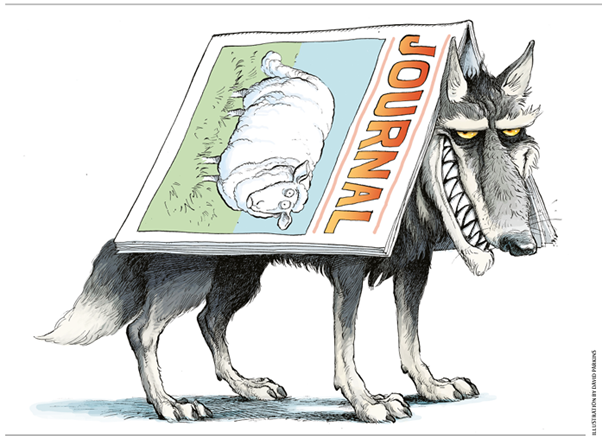Predatory open-access publishing is an exploitative open-access academic publishing business model that involves charging publication fees to authors without checking submitted manuscripts for quality and legitimacy. Predatory publishers do not provide editorial and publishing services that legitimate journals, whether open access or not.
Jeffrey Beall, a librarian at the University of Colorado, was the first to coin the term “predatory publishing”. The very popular Beall’s list of potential predatory journals and publishers was first published in 2008 and shut down in January 2017 due to several legal cases. After the closure of Beall’s list there were several efforts by others to continue with this list, such as ‘Stop predatory journals’, Cabell’s blacklist, and Fidelior.
It is almost impossible to keep up with all the predatory journals and publishers that appear and disappear on an annual basis. Therefore, this article will address the most common characteristics or indicators to look out for in identifying a predatory publication yourself and not relying on any lists.
The following are some things to look out for:
- An invitation to publish via overly flattering e-mails. These will often appear as spam, or they will use the incorrect title to address you such as Dr. or Prof.
- Email solicitation for papers that are outside your research scope or expertise.
- Deception/hijacking titles whereby the same journal title as a well-known existing journal is used.
- A broad journal title that includes subject fields not normally grouped together.
- Charging of exuberant author fees (more than $5,000.)
- High acceptance rate (more than 50%)
- There are no guidelines for authors to submission of manuscripts.
- A rapid publication that allows for little or no peer review.
- Allowing authors to publish plagiarised, copyrighted, or questionable content.
- No revisions are required from the authors. Their work would be published without any changes. What you originally submitted will be published as is, with mistakes included if there are any.
- The journal doesn't have an ISSN or DOI (digital object identifier).
- There is little to no proof of peer review.
- There is a lack of ethics policies and a need for declarations of conflict of interest, funding, and ethics.
- Check whether the journal is indexed by typical databases in the research field of interest.
- Journal claims to have an impact factor – check the Journal Citation Reports to confirm this. Only journals indexed in the Web of Science will have Impact Factors. Scopus journals will have a CiteScore.
- Editorial board members have:
- No affiliation, experience, or contact details;
- Gmail or Yahoo email addresses (not academic or known publisher addresses such as [email protected]);
- Do the people that are included even know they are on the editorial board or was their information stolen?
- Fake journal websites:
- The journal website does not exist;
- It is poorly maintained;
- There are spelling mistakes ;
- There are dead links.
- Lastly: trust your judgment as a researcher and potential author.
There is also a website called Think Check Submit that assists with educating researchers, promoting integrity, and building trust in credible research and publications.
It is suggested to rather go with a whitelist than a blacklist. The South African Department of Higher Education and Training (DHET) annually provides seven lists of reputable accredited journals that they recommend that researchers publish in. The journals in these lists were scrutinized by academic experts and are trustworthy. Amongst the seven lists is the DOAJ (Directory of Open Access Journals) list, consisting of over 17 000 accredited open-access journals.
In conclusion, it is recommended that all researchers develop the skills to identify a reputable journal as part of their scholarly communication skills. There is a subject guide on Predatory Publications for more information on this topic and the information specialists in the library, are trained to also assist in this regard.
For more information see the Predatory Publications subject guide.

Illustration by David Parkins
Catch up on other articles in the series:

Get Social With Us
Download the UP Mobile App